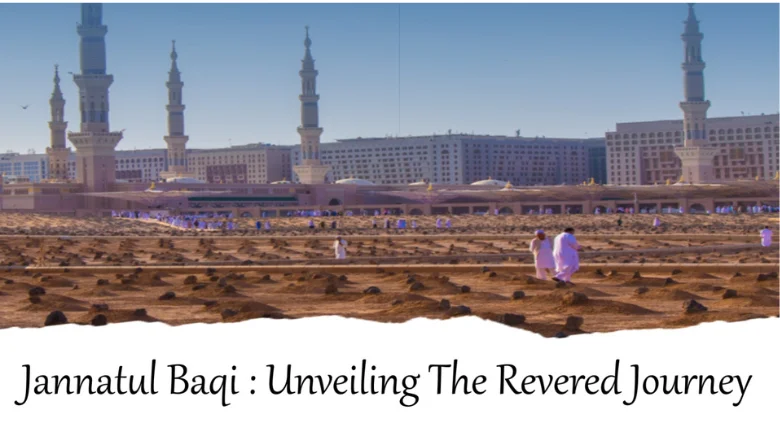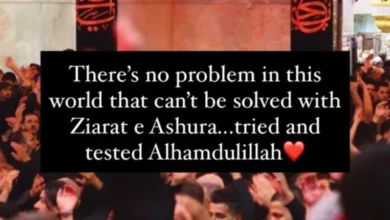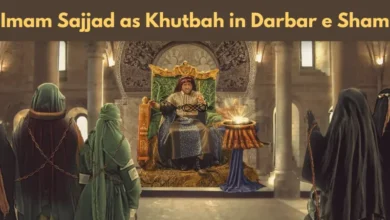
In this article you will know about the history of Cemetery of Jannatul Baqi, where history unfolds with each passing moment. This sacred burial ground, nestled in the heart of Medina, Saudi Arabia, holds a profound significance for Muslims around the globe. With a rich and intriguing history spanning centuries, going through history Jannatul Baqi bears witness to the legacies of numerous esteemed personalities, including companions of the Prophet Muhammad (peace be upon him) and their descendants.
The Jannatul Baqi shows delve into the depths of time as we embark on a mesmerizing journey through the annals of history, unearthing tales of devotion, spirituality, and the everlasting impact left by those who rest within its hallowed grounds. Join us as we unravel the mysteries and stories that make the history of Jannatul Baqi a treasure trove of the past.
History of the Cemetery of Jannatul Baqi
Syedda Fatima Zahra, daughter of the Holy Prophet, Imam Hasan Ibn Ali, Imam Ali Ibn Al-Husayn, Imam Muhammad Ibn Ali, and Imam Ja’far Ibn Muhammad, peace be upon them, are all buried at Jannatul Baqi.
King Ibn Saud tore down tombs in Jannatul Baqi (Madina) on the 8th Shawwal, which was a Wednesday, on April 21, 1345 AH.
In the same year, 1925, he also destroyed the holy people’s graves at Jannatul Baqi (Makkah), where the Holy Prophet’s (s) mother, wife, grandfather, and other ancestors are buried.
Even now, the Saudi Wahhabis are still destroying holy places in Hijaz. Some scholars say that what is going on in Hijaz is actually a plan by Jews against Islam that is being masked as Tawheed. The goal is to wipe out the Islamic legacy and history and get rid of all traces of it, so that Muslims will have nothing to do with their faith past in the future.
Where Jannatul Baqi Came From?
“Al-Baqi” means “a tree garden” in Arabic. It is also called “Jannatul Baqi” because it is a holy place where many cousins and friends of the Prophet are buried.
When we start to know about Jannatul Baqi Uthman Ibn Madhoon was the first friend to be buried in Al-Baqi. He died on the 3rd of Sha’ban in the 3rd year of Hijrah. The Prophet (s) told people to cut down some trees, and in the middle of them, he buried his close friend and put two stones on top of the grave.
In the years that followed, the Prophet’s young son Ibrahim, whose death broke the Prophet’s heart, was also buried there. The people of Madina started to bury their own dead there because the Prophet (s) would say to those who were buried in Al-Baqi, “Peace be upon you, O home of the faithful! God willing, we’ll be with you soon. God, please forgive al-Baqi’s people.
The cemetery at Jannatul Baqi got bigger and bigger over time. There are the graves of the Ahlul Bayt (a) and almost 7,000 people who were close to the Holy Prophet (s). There are the graves of Imam Hasan Ibn Ali, Imam Ali Ibn Al-Husayn, Imam Muhammad Al-Baqir, and Imam Ja’far Al-Sadiq.
His aunts Safiya and Aatika, as well as his aunt Fatima Bint Al-Asad, who was the mother of Imam Ali (a), were also buried at al-Baqi. Uthman, the third caliph, was buried outside of al-Baqi, but as the area grew, his grave became part of it. In later years, Malik Ibn Anas and other great Muslim thinkers were also buried there. So, al-Baqi became a famous place with a lot of historical importance for all Muslims.
Jannatul Baqi as seen by scholars Umar Ibn Jubair says, “Al-Baqi is to the east of Madina. You get there through a gate called the Gate of al-Baqi. As you walk in, the first grave you see on your left is that of the Prophet’s aunt, Safiya. The next grave you see is that of the Imam of Madina, Malik bin Anas. A small dome has been built over his grave.
In front of it is the grave of Ibrahim, the son of our Prophet (s), which has a white dome on top. To the right of it is the grave of Abdul-Rahman, the son of Umar bin Al-Khattab, who was known as Abu Shahma and whose father kept beating him until he died. The graves of Aqeel bin Abi Talib and Abdullah bin Ja’far Al-Tayyar are on the other side of it. There, on the other side of those graves, is a small shrine with the graves of the Prophet’s wives inside. After that is a shrine for Abbas bin Abdul Muttalib.
The grave of Hasan bin Ali (a) has a high dome over it. It is near the gate on the right side of it. His head is at the feet of Abbas bin Abdul Muttalib’s grave. Both graves are high off the ground and made of yellow plates and nails in the shape of stars.
This is also how Ibrahim, the son of the Prophet (s), was buried. Behind the shrine of Abbas is the house that is said to belong to Fatima, the daughter of our Prophet (s). It is called “Bayt Al-Ahzaan” (the house of grief) because that is where she would go to mourn the death of her father, the chosen one, peace be upon him. At the far end of al-Baqi, there is a small roof over the grave of Caliph Uthman, and right next to it is the grave of Fatima bint Asad, the mother of Ali b. Abi Talib (a).
After a century and a half, the great traveller Ibn Batuta talked about Jannatul Baqi in a way that was exactly the same as what Ibn Jubair had said. He adds, “At Jannatul Baqi are the graves of many Muhajirin, Ansar, and companions of the Prophet (s), but most of their names are unknown.”
So, Jannatul Baqi stayed a holy place for hundreds of years, with repairs being done as needed, until the Wahhabis came to power in the early 1800s. The latter broke the tombs’ rules and showed no respect for the victims and Prophet’s friends who were buried there. They called Muslims who didn’t agree with them “infidels” and then killed them.
The Wahhabis thought that going to the graves and sites of Prophets, Imams, or saints was a form of idolatry and completely against Islam. People who didn’t believe the same way as them were killed, and their property was taken away. Since their first attack of Iraq, and even up to the present day, the Wahhabis and other leaders of the Gulf States have been killing Muslims who don’t agree with them in massacres.
Those graves were obviously treated with great respect by the rest of the Islamic World. If it weren’t true, Abu Bakr and Umar would not have said they wanted to be buried near where the Prophet was.
From 1205 AH to 1217 AH, the Wahhabis tried several times but failed to establish themselves in Hijaz. In the end, in 1217 AH, they were able to win in Taif, where they killed innocent Muslims. In the year 1218 AH, they went to Makkah and burned all the holy places and domes there, including the one that covered the well of Zamzam.
In 1221, the Wahhabis went to Madina to disrespect Jannatul Baqi and all the mosques they could find. Even trying to destroy the Prophet’s tomb was tried, but the plan was dropped for one reason or another. In the years that followed, Muslims from Iraq, Syria, and Egypt were not allowed to do Hajj in Makkah. King Al-Saud made it so that people who wanted to go on the journey had to agree with Wahhabism. If they didn’t, they would be labelled as not being Muslim and wouldn’t be allowed into the Haram.
Jannatul Baqi was torn down, and there was no sign of a grave or tomb anywhere. But the Saudis were still not happy with what they had done. Their king told three black people who worked at the shrine of the Prophet to show him where the valuable gifts were kept. The Wahhabis stole the wealth to use it for themselves.
Thousands of Muslims left Makkah and Madina to save their lives and get away from the Wahhabis’ increasing pressure and oppression. Muslims from all over the world spoke out against Saudi Arabia’s brutality and asked the Caliphate of the Ottoman Empire to stop the destruction of the holy sites especially Jannatul Baqi .
Then, according to history, Muhammad Ali Basha struck Hijaz and, with the help of local tribes, brought law and order back to Madina and Makkah, getting rid of the Al-Saud clansmen. Everyone in the Muslim world was very happy and excited about this win. The parties went on for five days in Cairo. No question, people were happy because pilgrims were once again free to go to Hajj, and the holy sites were once again in good shape.
In the year 1818, the Ottoman Caliph Abdul Majid and his two successors, Caliphs Abdul Hamid and Mohammed, rebuilt all the holy places and brought back the Islamic tradition at all the most important sites. Between the years 1848 and 1860 AD, more renovations were done. They cost nearly 700,000 pounds, most of which came from gifts made at the Prophet’s tomb.
The Ottoman Empire added to the beauty of Madina and Makkah by building very beautiful and architecturally important holy buildings. Richard Burton, who visited the holy sites in 1853 AD while pretending to be an Afghan Muslim and taking the Muslim name Abdullah, says that Madina has 55 mosques and holy shrines.
Another English traveller who went to Madina between 1877 and 1878 says that it is a small, beautiful city that reminds him of Istanbul. He writes about how it has white walls, thin minarets made of gold, and green fields.
1924, Wahhabis went back to Hijaz for the second time and stole and killed a lot of people. People in streets were killed. Houses were completely destroyed. Not even women and children were safe.
Awn bin Hashim, who is the Shairf of Makkah, writes, “Before me, a valley looked like it was covered with dead bodies, with dried blood stains all over. Near the roots of almost every tree, there were one or two dead bodies.”
1925, Madina gave in to the Wahhabis’ attack. All of the Islamic past was wiped out. The Holy Prophet’s (s) shrine was the only one that was still in good shape.
Ibn Jabhan says, “We know that the tomb on the Prophet’s grave goes against our beliefs, and having his grave in a mosque is a terrible sin.”
At Uhud, the tombs of Hamza and other heroes were torn down. The mosque of the Prophet was hit with bombs. Ibn Saud promised Muslims that it would be brought back after they protested, but he never kept his word. A promise was made that Hijaz will have a government made up of Muslims from all over the world. This, too, was dropped.
In the year 1925, AD, Jannat Al-Mu’alla, the holy graveyard in Makkah, and the house where the Holy Prophet (s) was born were both destroyed. Since then, all Muslims have been sad on this day ever since.
Is it not strange that the Wahhabis find it offensive to protect tombs, churches, and other important places, but they are willing to spend millions of dollars to protect the bodies of their Saudi kings?
Muslims make a fuss first time for Jannatul Baqi
Muslims from all over the world got together to protest in 1926. Resolutions were passed, and a statement was put out with a list of the sins that Wahhabis had committed.
- The destruction and desecration of holy places, such as the place where the Holy Prophet was born, the graves of Banu Hashim in Makkah and in Jannatul Baqi (Madinah), and the Wahhabis’ failure to let Muslims say the Ziyarah or Surah Al-Fatiha at these graves.
- The destruction of places of worship, such as Masjid Hamza and Masjid Abu Rasheed, as well as the tombs of Imams and Sahaba, who were close friends of the Prophet.
- Interfering with the way Hajj practises are done.
- Making Muslims follow the new ideas of the Wahhabis and give up their own ways, based on what their Imams tell them.
Sayyids were killed in Taif, Madina, Ahsa, and Qatif.
- The grave of the Imams at Jannatul Baqi was torn down, which made all Shias very angry and sad.
Objections from other nations about Jannatul Baqi
Muslims in Iran, Iraq, Egypt, Indonesia, and Turkey all held protests that were the same. All of them say that the cruel things the Saudi Wahhabis do are wrong. Some scholars wrote pamphlets and books to tell the world that what was going on in Hijaz was actually a plan against Islam by the Jews called Tawheed.
The goal was to get rid of Islam’s history and memory and to get rid of all traces of it, so that in the future, Muslims will have nothing to do with their religion’s past.
Here is a selection of the destroyed tombs and temples.Al-Mualla Cemetery in Makkah, where the Prophet’s wife, Sayyida Khadija bint Khuwailid (a), as well as the Prophet’s mother, Amina bint Wahab (a), Abu Talib (a), the father of Imam Ali (a), and the Prophet’s grandfather, Abdul Muttalib (a), are buried. Hawa’s (Eve’s) tomb in Jeddah
Madina is home to many important religious sites, including: the burial of the Prophet’s father; Sayyida Fatima’s house of grief (Bayt Al-Ahzan); the Salman al-Farsi mosque; the Raj’at ash-Shams mosque; and the grave of the Prophet himself.
Places of interest in Madina include: Jannatul Baqi, the Prophet’s (s) house, where he lived after moving there from Makkah; Imam Ja’far Al-Sadiq’s (a) house; the Banu Hashim complex (mahhalla) in Madina; Imam Ali’s (a) house, where Imams Hasan (a) and Husayn (a) were born; Hamza’s (a) house and the graves of the martyrs.To know about more Holy Shrines of Ahlul Bayt please visit ziyarat/Shrines.




